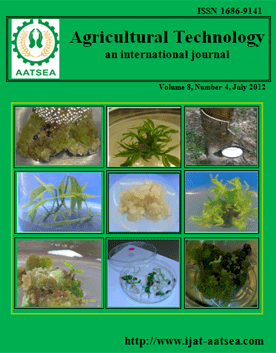ThaiScience
ThaiScience
INTERNATIONAL JOURNAL OF AGRICULTURAL TECHNOLOGY
Volume 14, No. 07, Month DECEMBER, Year 2018, Pages 1279 - 1286
Effect of dietary organic and inorganic selenium on carcass composition and meat characteristics of broiler chickens
Jamnongtoi, P., Sivapirunthep, P. and Chaosap, C.
Abstract Download PDF
The effects of organic Zn-L-selenomethionine (Zn-L-SeMet) and inorganic sodium selenite (Na-Se) on broiler chickens’carcass composition and meat characteristics were compared. The 360 one-day-old broiler chickens subjected to a 3 phases feeding program with basal diets of corn-soy. The chickens were divided into 2 groups supplemented with 0.3 ppm of Zn-L-SeMet or Na-Se throughout 37 days of raising period. Each treatment consisted of 6 replicated with 30 male broilers. Birds were deprived of feed for 12 h and weighed prior to slaughter. Three birds from each treatment replicate were sacrificed by cervical dislocation before carcass compositions were measured. Breast muscles were collected and then determined meat characteristics. Carcass composition was not affected (P>0.05) by different selenium sources. Chicken fed Zn-L-SeMet had higher cooking loss and lower color of L* value compared to those fed with Na-Se. Shear force value of Zn-L-SeMet was significant lower than Na-Se at 1 day postmortem but the effect of selenium sources was not significant later than at 4 day post mortem.
Keywords
Zn-L-Selenomethionine, Sodium Selenite, Carcass Composition, Meat Characteristics, Broiler ChickenINTERNATIONAL JOURNAL OF AGRICULTURAL TECHNOLOGY
Published by : Association of Agricultural Technology in Southeast Asia (AATSEA)
Contributions welcome at : http://www.ijat-aatsea.com
